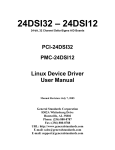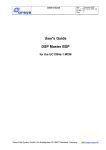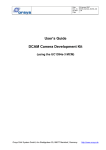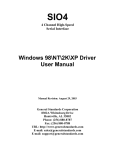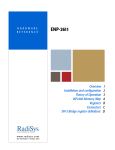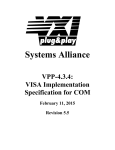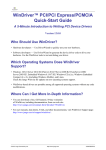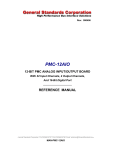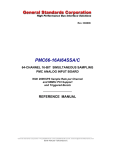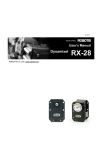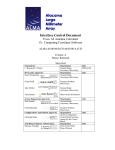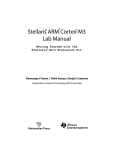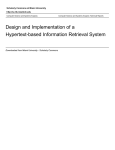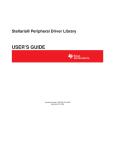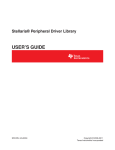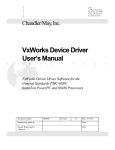Download Windows 98\NT\2K\XP Driver User Manual
Transcript
24DSI 24-Bit, 32 Channel Sigma-Delta, Analog Input Windows 98\NT\2K\XP Driver User Manual Manual Revision: February 6, 2004 General Standards Corporation 8302A Whitesburg Drive Huntsville, AL 35802 Phone: (256) 880-8787 Fax: (256) 880-8788 URL: http://www.generalstandards.com E-mail: [email protected] E-mail: [email protected] Preface Copyright ©?2002, General Standards Corporation Additional copies of this manual or other literature may be obtained from: General Standards Corporation 8302A Whitesburg Dr. Huntsville, Alabama 35802 Phone: (256) 880-8787 FAX: (256) 880-8788 URL: http://www.generalstandards.com E-mail: [email protected] General Standards Corporation makes no warranty of any kind with regard to this material, including, but not limited to, the implied warranties of merchantability and fitness for a particular purpose. Although extensive editing and reviews are performed before release to ECO control, General Standards Corporation assumes no responsibility for any errors that may exist in this document. No commitment is made to update or keep current the information contained in this document. General Standards Corporation does not assume any liability arising out of the application or use of any product or circuit described herein, nor is any license conveyed under any patent rights or any rights of others. General Standards Corporation assumes no responsibility for any consequences resulting from omissions or errors in this manual or from the use of information contained herein. General Standards Corporation reserves the right to make any changes, without notice, to this product to improve reliability, performance, function, or design. ALL RIGHTS RESERVED. The Purchaser of this software may use or modify in source form the subject software, but not to re-market or distribute it to outside agencies or separate internal company divisions. The software, however, may be embedded in the Purchaser’s distributed software. In the event the Purchaser’s customers require the software source code, then they would have to purchase their own copy of the software. General Standards Corporation makes no warranty of any kind with regard to this software, including, but not limited to, the implied warranties of merchantability and fitness for a particular purpose and makes this software available solely on an “as-is” basis. General Standards Corporation reserves the right to make changes in this software without reservation and without notification to its users. The information in this document is subject to change without notice. This document may be copied or reproduced provided it is in support of products from General Standards Corporation. For any other use, no part of this document may be copied or reproduced in any form or by any means without prior written consent of General Standards Corporation. GSC is a trademark of General Standards Corporation. PLX and PLX Technology are trademarks of PLX Technology, Inc. 2 General Standards Corporation, Phone: (800) 653-9970 Table of Contents 1. 2. 3. 4. Scope………………………………………………………………………….. Hardware Overview…………………………………………………………. Referenced Documents…………………………………………………….. General Standards API……………………………………………………… 4.1 4.2 4.3 4.4 4.5 4.6 5. 6. 4 5 6 7 DSI_FindBoards()………………………………………………………... DSI_Get_Handle()………………………………………………………… DSI_Read_Local32()……………………………………………………... DSI_Write_Local32()……………………………………………………... DSI_Close_Handle()……………………………………………………… Interface Functions……………………………………………………… 8 9 10 11 12 13 4.6.1 DSI_Initialize()…………………………………………………… 4.6.2 DSI_Autocal()……………………………………………………. 4.6.3 DSI_Set_Input _Mode()…………..……………………………. 4.6.4 DSI_Set_Voltage_Range()…..…..……………………………. 4.6.5 DSI_Clear_Buffer()……………………………………………… 4.6.6 DSI_Buffer_Control()……..…………………………………… 4.6.7 DSI_Set_Data_Width()………………………………………… 4.6.8 DSI_EnableInterrupt()………………………………………….. 4.6.9 DSI_DisableInterrupt()…………………………………………. 4.6.10 DSI_Open_DMA_Channel()……...……………………………. 4.6.11 DSI_DMA_ToVirtualMem()……………………………………. 4.6.12 DSI_DMA_ToPhysicalMem()…………………………………. 4.6.13 DSI_Close_DMA_Channel()…………………………………… 4.6.14 DSI_Attach_Interrupt()….…….………………………………. 4.6.15 DSI_ReAttach_Interrupt()….….………………………………. Driver Installation……………………………………………………………… Example Program……………………………………………………………… 13 14 15 16 17 18 19 20 21 22 23 24 25 26 27 29 30 3 General Standards Corporation, Phone: (800) 653-9970 1. Scope The Purpose of this document is to describe how to interface with the 24DSI Windows Driver API developed by General Standards Corporation (GSC). This software provides the interface between the “Application Software” and the 24DSI board. The 24DSI Driver API Software executes under control of the Windows Operating System. The 24DSI is implemented as a standard Windows driver API written in “C” programming language. The 24DSI Driver API Software is designed to operate on CPU boards containing x86 processors. The 24DSI Driver consists of a Windows driver with an interface layer (GSC API) to simplify the interface to the PLX Driver. While an application may interface directly to the PLX driver, interfacing to the GSC API layer, will simplify the application software development. 4 General Standards Corporation, Phone: (800) 653-9970 2. Hardware Overview The 24DSI board is a single-width board that provides 24-bit analog input. In addition to providing thirty-two analog input channels and two or more independently adjustable rate generators, the board supports multi-board clocking and synchronization. The board is functionally and mechanically compatible with the IEEE PCI local bus specification Revision 2.2, and supports the "plug-n-play" initialization concept. Power requirements consist of +5 VDC in accordance with the PCI specification, and operation over the specified temperature range is achieved with minimal (200 LFPM) air-cooling. Specific details pertaining to physical characteristics and performance are contained in the PCI24DSI32 product specification. The board is designed for minimum off-line maintenance, and includes internal monitoring features that eliminate the need for disconnecting or removing the module from the system for calibration. All system input and output system connections are made at the panel bracket through a 100-pin dual-ribbon cable connector. ** Number of Channels and Rate Generators available are dependant on the ordering options provided by the customer. 5 General Standards Corporation, Phone: (800) 653-9970 3. Referenced Documents The following documents provide reference material for the 24DSI board: • • PCI-24DSI32 User’s Manual – GSC PLX Technology, Inc. PCI 9080 PCI Bus Master Interface Chip data sheet. 6 General Standards Corporation, Phone: (800) 653-9970 4. General Standards API This section describes the interface to the 24DSI GSC API. The 24DSI GSC API isolates the user from operating system specific requirements, allowing the API to be used with all Windows operating systems (98\NT\W2K\ XP). The 24DSI Win Driver provides an interface to a 24DSI card and a Windows application, which run on a x86 target processor. The driver is installed and devices are created when the driver is started during boot up. The functions of the driver can then be used to access the board. Devices are created with the name “board x” where “x” is the device number. Device numbers start at 1 and for each board found the device number will increment. Included in the board driver software is a menu driven board application program. This program is delivered undocumented and unsupported but may be used to exercise the card and the device driver. It can also be used as an example for programming the 24DSI device. The user interfaces to the GSC API at the basic level with the following functions: • Find Boards() - Detects all PLX Devices connected via the PCI Bus. • Get Handle() - Opens a driver interface to one 24DSI card. • Readlocal32() - Reads local registers from one 24DSI card. • Writelocal32() - Writes to local Registers of one 24DSI card. • Close Handle() - Closes a driver interface to one 24DSI card. The user MUST call Find Boards to determine what PLX devices are installed in the system, and get the associated board number. The user then calls the Get Handle function with each board number to be used. This function obtains a handle to the device and initializes the device parameters within the API / driver. The user is then free (assuming no errors) to write / read the registers as desired. The user should always call Close Handle when done to free resources prior to exiting. The function definitions and parameters are defined in the following paragraphs of this section. ** Number of Rate Generator and Rate Divisor Registers listed throughout this document are dependent on the ordering options provided by the customer. 7 General Standards Corporation, Phone: (800) 653-9970 4.1 DSI_FindBoards() Detects all PLX Devices connected via the PCI Bus. Prototype: U32 DSI_FindBoards (char U32 *pDeviceInfo, *ulError); Returns – Total number of PLX boards found in the system or –1L if error or no boards found. Where: pDeviceInfo – Contains “Board #: Bus: Slot: Type: Ser#” info for PLX boards found. ulError – Returns 0 or error code. Refer to tools.h for a list of error codes. 8 General Standards Corporation, Phone: (800) 653-9970 4.2 DSI_Get_Handle Initializes Handle for the passed board number IN THE DRIVER. Prototype: U32 DSI_Get_Handle (U32 U32 *ulError, BoardNumber); Returns – Error code if invalid board number passed (0, >31), else # boards. Where: BoardNumber – Defines board number to be used by the driver for a particular device. ulError – Returns 0 or error code. Refer to tools.h for a list of error codes. 9 General Standards Corporation, Phone: (800) 653-9970 4.3 DSI_Read_Local32 Read a value from the board local register. Prototype: U32 DSI_Read_Local32 (U32 U32 U16 BoardNumber, *ulError, iRegister); Returns – Value read from the register. Where: BoardNumber – Defines board number to be used by the driver for a particular device. ulError – Returns 0 or error code. Refer to tools.h for a list of error codes. iRegister – Register to read. Values defined in DSIintface.h BCR 0x00 RATE_CONTROL_AB 0x04 RATE_CONTROL_CD 0x08 RATE_ASSIGN 0x0C RATE_DIV 0x10 Reserved0 0x14 Reserved1 0x18 Reserved2 0x1C BUFFER_CONTROL 0x20 BOARD_CONFIG 0x24 BUFF_SIZE 0x28 AUTOCAL 0x2C INPUT_DATA_BUFFER 0x30 Reserved3 0x34 Reserved4 0x38 Reserved5 0x3C Reserved6 0x40 ** Number of Rate Generator and Rate Divisor Registers listed above are dependent on the ordering options provided by the customer. 10 General Standards Corporation, Phone: (800) 653-9970 4.4 DSI_Write_Local32 Write a value to the board local register. Prototype: void DSI_Write_Local32 (U32 U32 U16 U32 BoardNumber, *ulError, iRegister uiValue); Returns – N/A Where: BoardNumber – Defines board number to be used by the driver for a particular device. ulError – Returns 0 or error code. Refer to tools.h for a list of error codes. iRegister – Register to write. Values defined in DSIintface.h BCR 0x00 RATE_CONTROL_AB 0x04 RATE_CONTROL_CD 0x08 RATE_ASSIGN 0x0C RATE_DIV 0x10 Reserved0 0x14 Reserved1 0x18 Reserved2 0x1C BUFFER_CONTROL 0x20 BOARD_CONFIG 0x24 BUFF_SIZE 0x28 AUTOCAL 0x2C INPUT_DATA_BUFFER 0x30 Reserved3 0x34 Reserved4 0x38 Reserved5 0x3C Reserved6 0x40 uiValue – Value to write to the selected register. Refer to the 24DSI user manual for all register / bit definitions. 11 General Standards Corporation, Phone: (800) 653-9970 4.5 DSI_Close_Handle Closes the device handle and frees the resources. Prototype: void DSI_Close_Handle (U32 U32 BoardNumber, *ulError); Returns – N/A Where: BoardNumber – Defines board number to be used by the driver for a particular device. ulError – Returns 0 or error code. Refer to tools.h for a list of error codes. 12 General Standards Corporation, Phone: (800) 653-9970 4.6 Interface Functions These functions allow the user to perform certain operations on the board, without having to keep track of individual register values and bit definitions. 4.6.1 DSI_Initialize Perform a reset on the board. All register values are set to defaults. Prototype: void DSI_Initialize (U32 U32 BoardNumber, *ulError); Returns – N/A Where: BoardNumber – Defines board number to be used by the driver for a particular device. ulError – Returns 0 or error code. Refer to tools.h for a list of error codes. 13 General Standards Corporation, Phone: (800) 653-9970 4.6.2 DSI_Autocal Perform an auto calibration on the board. This operation generates new calibration correction values which are stored in nonvolatile EEprom. Prototype: void DSI_Autocal (U32 U32 BoardNumber, *ulError); Returns – N/A Where: BoardNumber – Defines board number to be used by the driver for a particular device. ulError – Returns 0 or error code. Refer to tools.h for a list of error codes. 14 General Standards Corporation, Phone: (800) 653-9970 4.6.3 DSI_Set_Input_Mode Sets the input mode of the board: Differential, Single-Ended, or SelfTest (Zero or +Vref). Prototype: void DSI_Set_Input_Mode (U32 U32 U32 BoardNumber, *ulError ulInputMode); Returns – N/A Where: BoardNumber – Defines board number to be used by the driver for a particular device. ulError – Returns 0 or error code. Refer to tools.h for a list of error codes. ulInputMode – Valid values: Differential (0), SE (1), Zero SelfTest (2), VREF SelfTest (3). 15 General Standards Corporation, Phone: (800) 653-9970 4.6.4 DSI_Set_Voltage_Range Sets the input voltage range of the board: ±2.50, ±5.00, ±10.00. Prototype: void DSI_Set_Voltage_Range (U32 U32 U32 BoardNumber, *ulError ulRange); Returns – N/A Where: BoardNumber – Defines board number to be used by the driver for a particular device. ulError – Returns 0 or error code. Refer to tools.h for a list of error codes. ulRange – Valid values: ±2.50 (0,1), ±5.00 (2), ±10.00 (3). 16 General Standards Corporation, Phone: (800) 653-9970 4.6.5 DSI_Clear_Buffer Clears all data from the input buffer. Prototype: void DSI_Clear_Buffer (U32 U32 BoardNumber, *ulError); Returns – N/A Where: BoardNumber – Defines board number to be used by the driver for a particular device. ulError – Returns 0 or error code. Refer to tools.h for a list of error codes. 17 General Standards Corporation, Phone: (800) 653-9970 4.6.6 DSI_Buffer_Control Enables / Disables the input data buffer. Prototype: void DSI_Buffer_Control (U32 U32 U32 BoardNumber, ulValue, *ulError); Returns – N/A Where: BoardNumber – Defines board number to be used by the driver for a particular device. ulValue – Valid Values: 0 = Disable , 1 = Enable input buffer. ulError – Returns 0 or error code. Refer to tools.h for a list of error codes. 18 General Standards Corporation, Phone: (800) 653-9970 4.6.7 DSI_Set_Data_Width Sets the desired data width: 16, 18, 20, or 24 bit. Prototype: void DSI_Set_Width (U32 U32 U32 BoardNumber, ulWidth, *ulError); Returns – N/A Where: BoardNumber – Defines board number to be used by the driver for a particular device. ulWidth – Valid Values: 0 = 16bit , 1 = 18bit, 2 = 20bit, 3 = 24bit. ulError – Returns 0 or error code. Refer to tools.h for a list of error codes. 19 General Standards Corporation, Phone: (800) 653-9970 4.6.8 DSI_EnableInterrupt Enables the desired interrupt in the local register, and for the PCI bus. See 24DSI User manual for interrupt sources. Prototype: U32 DSI_EnableInterrupt (U32 U32 U32 BoardNumber, ulValue, *ulError); Returns – Interrupt value set. Where: BoardNumber – Defines board number to be used by the driver for a particular device. ulValue – The desired interrupt value to set, valid for 0 – 7. ulError – Returns 0 or error code. Refer to tools.h for a list of error codes. 20 General Standards Corporation, Phone: (800) 653-9970 4.6.9 DSI_DisableInterrupt Disables the interrupt in the local register, and for the PCI bus. Prototype: void DSI_DisableInterrupt (U32 U32 U32 BoardNumber, ulValue, *ulError); Returns – N/A. Where: BoardNumber – Defines board number to be used by the driver for a particular device. ulValue – The desired interrupt value to disable, valid for 0 – 7. ulError – Returns 0 or error code. Refer to tools.h for a list of error codes. 21 General Standards Corporation, Phone: (800) 653-9970 4.6.10 DSI_Open_DMA_Channel Opens the desired DMA channel for transferring data from the board input buffer. Prototype: void DSI_Open_DMA_Channel (U32 U32 U32 BoardNumber, ulChannel, *ulError); Returns – N/A. Where: BoardNumber – Defines board number to be used by the driver for a particular device. ulChannel – The desired channel to open, valid for channel 0 or 1 . ulError – Returns 0 or error code. Refer to tools.h for a list of error codes. 22 General Standards Corporation, Phone: (800) 653-9970 4.6.11 DSI_DMA_ToVirtualMem Transfers the desired number of WORDS from the board input buffer to user defined memory. Prototype: U32 DSI_DMA_ToVirtualMem (U32 U32 U32 U32* U32 BoardNumber, ulChannel, ulWords, uData, *ulError); Returns – WORDS transferred if no error. Where: BoardNumber – Defines board number to be used by the driver for a particular device. ulChannel – The DMA channel previously opened, valid for channel 0 or 1. ulWords – Number of WORDS to transfer. (BYTES = ulWords*4). uData – User defined (Virtual) memory. ulError – Returns 0 or error code. Refer to tools.h for a list of error codes. 23 General Standards Corporation, Phone: (800) 653-9970 4.6.12 DSI_DMA_ToPhysicalMem Transfers the desired number of WORDS from the board input buffer to a physical contiguous memory block. Prototype: U32 DSI_DMA_ToPhysicalMem(U32 U32 U32 U32* U32 BoardNumber, ulChannel, ulWords, uData, *ulError); Returns – WORDS transferred if no error. Where: BoardNumber – Defines board number to be used by the driver for a particular device. ulChannel – The DMA channel previously opened, valid for channel 0 or 1. ulWords – Number of WORDS to transfer. (BYTES = ulWords*4). uData – Pointer to physical memory. NOTE: MUST be a contiguous memory block. ulError – Returns 0 or error code. Refer to tools.h for a list of error codes. 24 General Standards Corporation, Phone: (800) 653-9970 4.6.13 DSI_Close_DMA_Channel Closes the desired DMA channel. Prototype: void DSI_Close_DMA_Channel (U32 U32 U32 BoardNumber, ulChannel, *ulError); Returns – N/A. Where: BoardNumber – Defines board number to be used by the driver for a particular device. ulChannel – The desired channel to close, valid for channel 0 or 1. ulError – Returns 0 or error code. Refer to tools.h for a list of error codes. 25 General Standards Corporation, Phone: (800) 653-9970 4.6.14 DSI_Attach_Interrupt Attaches a user supplied handle to an interrupt which can be used in WaitForSingleObject for notification when the interrupt occurs. A sample use is provided in the Autocal function of the example program. DSI_Attach_Interrupt(ulBdNum, &myHandle, 0x01, &ulErr); … … Setup and code to cause interrupt to happen … EventStatus = WaitForSingleObject(myHandle,10 * 1000); … switch(EventStatus) { case WAIT_OBJECT_0: … code to perform desired action break; default: cprintf("Interrupt was NOT requested..."); break; } Prototype: void DSI_Attach_Interrupt (U32 HANDLE U32 U32 BoardNumber, userHandle, ulInterrupt, *ulError); Returns – N/A. Where: BoardNumber – Defines board number to be used by the driver for a particular device. userHandle – User supplied handle for the event. ulInterrupt – The desired interrupt to attach to. Also enables the interrupt. ulError – Returns 0 or error code. Refer to tools.h for a list of error codes. 26 General Standards Corporation, Phone: (800) 653-9970 4.6.15 DSI_ReAttach_Interrupt ReAttaches a user supplied handle to an interrupt which WaitForSingleObject for notification when the interrupt occurs in loops. can be used DSI_Attach_Interrupt(ulBdNum, &myHandle, 0x01, &ulErr); … … Setup and code to cause interrupt to happen … loop begin EventStatus = WaitForSingleObject(myHandle,10 * 1000); … switch(EventStatus) { case WAIT_OBJECT_0: DSI_ReAttach_Interrupt(ulBdNum, &myHandle, &ulErr); … code to perform desired action break; default: cprintf("Interrupt was NOT requested..."); break; } loop end Prototype: void DSI_ReAttach_Interrupt (U32 HANDLE U32 BoardNumber, userHandle, *ulError); Returns – N/A. Where: BoardNumber – Defines board number to be used by the driver for a particular device. userHandle – User supplied handle for the event. ulError – Returns 0 or error code. Refer to tools.h for a list of error codes. 27 General Standards Corporation, Phone: (800) 653-9970 in 5. Driver Installation This section details driver installation on the target system. Any current driver previously installed for the 24DSI must be uninstalled prior to this installation to avoid interference. To install the driver, API, and associated example files, insert the CD ROM into the drive and close the bay. The installation should commence automatically and display user prompts. Follow the onscreen instructions to complete the installation. Should the installation fail to automatically start, Select Start → Run → Browse on the Windows toolbar/popup and browse to find Setup.exe on the CD ROM. Click on OK to commence the installation. The following files are installed on the target system: OS dependent\…\Pci24DSI.sys OS dependent\…\PlxApi.dll Program Files\General Standards\Sigma Delta C\ DSIDriverC.dll Program Files\General Standards\Sigma Delta C\ DSIDriverC.lib Program Files\General Standards\Sigma Delta C\ DSI Example.c Program Files\General Standards\Sigma Delta C\ Tools.c Program Files\General Standards\Sigma Delta C\ Tools.h Program Files\General Standards\Sigma Delta C\ CioColor.h Program Files\General Standards\Sigma Delta C\ DSIintface.h Program Files\General Standards\Sigma Delta C\ DSI Driver C.inf Program Files\General Standards\Sigma Delta C\Example.exe 28 General Standards Corporation, Phone: (800) 653-9970 6. Example Program This section describes the example program, and the files required to develop an application. The complied example program allows the user to exercise the installed device, while observing the inputs or outputs. To execute, double click on ‘Example.exe’. Refer to the Driver Installation section for file location. The source is provided to educate the user with the GSC API function calls and provide a working example to aid the user with application development. To build the example program using MS Visual C++, create a project and add the following files: Source Files → SDI Example.c → Tools.c Header Files → DSIintface.h → CioColor.h → Tools.h Resource Files → DSIDriverC.lib Select Build → [ProjectName].exe on the toolbar. NOTE: DSIDriverC.dll must be in the project directory or [Windows Dir]\ system32 to run the example. Contact GSC for example programs (drivers) for other development environments (i.e LabVIEW , LabWindows/CVI , etc.) 29 General Standards Corporation, Phone: (800) 653-9970





























